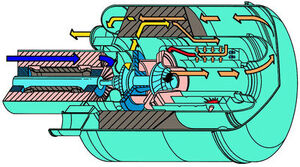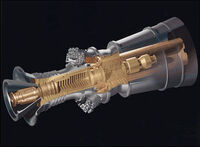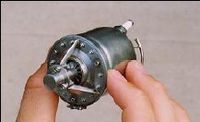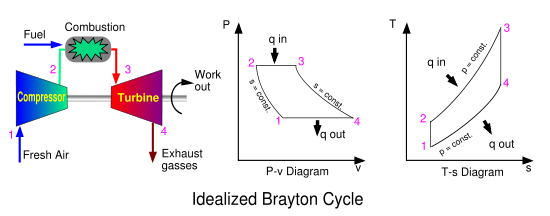
This machine has a single-stage radial compressor and turbine, a recuperator, and foil bearings.
A gas turbine, also called a combustion turbine, is a rotary engine that extracts energy from a flow of combustion gas.
Construction[]
It has an upstream compressor coupled to a downstream turbine, and a combustion chamber in-between. (Gas turbine may also refer to just the turbine element.)
Working[]
Energy is generated where air is mixed with fuel and ignited in the combustor. Combustion increases the temperature, velocity and volume of the gas flow. This is directed through a (nozzle) over the turbine's blades, spinning the turbine and powering the compressor.
Energy is extracted in the form of shaft power, compressed air and thrust, in any combination, and used to power aircraft, trains, ships, generators, and even tanks.
Theory of operation[]
Gas turbines are described thermodynamically by the Brayton cycle [1], in which air is compressed isentropically, combustion occurs at constant pressure, and expansion over the turbine occurs isentropically back to the starting pressure.
In practice, friction and turbulence cause:
- a) non-isentropic compression - for a given overall pressure ratio, the compressor delivery temperature is higher than ideal.
- b) non-isentropic expansion - although the turbine temperature drop necessary to drive the compressor is unaffected, the associated pressure ratio is greater, which decreases the expansion available to provide useful work.
- c) a pressure loss in the combustor - reduces the expansion available to provide useful work.
As with all cyclic heat engines, higher combustion temperature means greater efficiency. The limiting factor is the ability of the steel, ceramic, or other materials that make up the engine to withstand heat and pressure. Considerable engineering goes into keeping the turbine parts cool. Most turbines also try to recover exhaust heat, which otherwise is wasted energy. Recuperators are heat exchangers that pass exhaust heat to the compressed air, prior to combustion. Combined cycle designs pass waste heat to steam turbine systems. And combined heat and power (co-generation) uses waste heat for hot water production.
Complexity[]
Mechanically, gas turbines can be considerably less complex than internal combustion piston engines. Simple turbines might have one moving part: the shaft/compressor/turbine/alternator-rotor assembly (see image above), not counting the fuel system.
More sophisticated turbines may have multiple shafts (spools), hundreds of turbine blades, movable stator blades, and a vast system of complex piping, combustors and heat exchangers.
As a general rule, the smaller the engine the faster the shaft(s) rotate to maintain tip speed; jet engines operate around 10,000 rpm and micro turbines around 100,000 rpm.
Thrust bearings and journal bearings are a critical part of design. Traditionally, they have been hydrodynamic oil bearings, or oil-cooled ball bearings. This is giving way to hydrodynamic foil bearings, which have become common place in micro turbines and APU's (auxiliary power units.)
Gas turbines for electrical power production[]

GE H series power generation gas turbine. This 400-megawatt unit has a rated thermal efficiency of 60% in combined cycle configurations.
Industrial gas turbines range in size from truck-mounted mobile plants to enormous, complex systems.
The power turbines in the largest industrial gas turbines operate at 3,000 or 3,600 rpm to match the AC power grid frequency and to avoid the need for a reduction gearbox. Such engines require a dedicated building.
They can be particularly efficient—up to 60%—when waste heat from the gas turbine is recovered by a conventional steam turbine in a combined cycle configuration. They can also be run in a cogeneration configuration, where the exhaust is captured to heat steam which is then used to heat buildings or to run airconditioners through a steam turbine.
Simple cycle gas turbines in the power industry require smaller capital investment than combined cycle gas, coal or nuclear plants and can be designed to generate small or large amounts of power. Also, the actual construction process can take as little as several weeks to a few months, compared to years for baseload plants. Their other main advantage is the ability to be turned on and off within minutes, supplying power during peak demand. Hence they are sometimes called peaking turbine units. Large simple cycle gas turbines may produce several hundred megawatts of power and approach 40% thermal efficiency.
Micro Turbines[]

A micro turbine designed for DARPA by M-Dot
Also known as:
- Turbo alternators
- Gensets
Micro turbines are becoming wide spread for distributed power and combined heat and power applications. They range from handheld units producing less than a kilowatt to commercial sized systems that produce tens or hundreds of kilowatts.
Part of their success is due to advances in electronics, which allow unattended operation and interfacing with the commercial power grid. Electronic power switching technology eliminates the need for the generator to be synchronized with the power grid. This allows, for example, the generator to be integrated with the turbine shaft, and to double as the starter motor.
Micro turbine systems have many advantages over piston engine generators, such as higher power density (with respect to footprint and weight), extremely low emissions and few, or just one, moving part. Those designed with foil bearings and air-cooling operate without oil, coolants or other hazardous materials. However, piston engine generators are quicker to respond to changes in output power requirement.
They accept most commercial fuels, such as natural gas, propane, diesel and kerosene. The are also able to produce renewable energy when fueled with biogas from landfills and sewage treatment plants.
Micro turbine designs usually consist of a single stage radial compressor, a single stage radial turbine and a recuperator. Recuperators are difficult to design and manufacture because they operate under high pressure and temperature differentials. Exhaust heat can be used for water heating, drying processes or absorption chillers, which create cold for air conditioning from heat energy instead of electric energy.
Typical micro turbine efficiencies are 25 to 35%. When in a combined heat and power cogeneration system, efficiencies of greater than 80% are commonly achieved.
Auxiliary power units[]
Auxiliary power units (APUs) are small gas turbines designed for auxiliary power of larger machines, usually aircraft. They are well suited for supplying compressed air for aircraft ventilation (with an appropriate compressor design), start-up power for larger jet engines, and electrical and hydraulic power. (These are not to be confused with the auxiliary propulsion units, also abbreviated APUs, aboard the gas-turbine-powered Oliver Hazard Perry-class guided-missile frigates. The Perrys' APUs are large electric motors that provide maneuvering help in close waters, or emergency backup if the gas turbines are not working.)
Gas turbines in vehicles[]
Gas turbines are used on ships, locomotives, helicopters, and in tanks. A number of experiments have been conducted with gas turbine powered automobiles.
[]
Gas turbines are used in many naval vessels, where they are valued for their high power-to-weight ratio and their ships' resulting acceleration and ability to get underway quickly. The first gas-turbine-powered naval vessel was the Royal Navy's Motor Gun Boat MGB 2009 (formerly MGB 509) converted in 1947. The first large, gas-turbine powered ships, were the Royal Navy's Type 81 (Tribal class) frigates, the first of which (HMS Ashanti) was commissioned in 1961.
The next series of major naval vessels were the four Canadian Iroquois class helicopter carrying destroyers first commissioned in 1972. They used 2 FT-4 main propulsion engines, 2 FT-12 cruise engines and 3 Solar Saturn 750 KW generators.
Advances in technology[]
Gas turbine technology has steadily advanced since its inception and continues to evolve; research is active in producing ever smaller gas turbines. Computer design, specifically CFD and finite element analysis [2] along with material advances, has allowed higher compression ratios and temperatures, more efficient combustion, better cooling of engine parts and reduced emissions. Additionally, compliant foil bearings were commercially introduced to gas turbines in the 1990s. They can withstand over a hundred thousand start/stop cycles and eliminated the need for an oil system.
On another front, microelectronics and power switching technology have enabled commercially viable micro turbines for distributed and vehicle power. An excellent example is the Capstone line of micro turbines, which do not require an oil system and can run unattended for months on end.
See also[]
- Turbine
- Jet engine
- Brayton cycle [3]
Further reading[]
- Gas Turbine Engines for Model Aircraft by Kurt Schreckling [4], ISBN 0 9510589 1 6 Traplet Publications
- "Aircraft Gas Turbine Technology" by Irwin E. Treager, Professor Emeritus Purdue University, McGraw-Hill, Glencoe Division, 1979, ISBN 0-02-801828
External links[]
- World Alliance for Decentralized Energy
- MIT Gas Turbine Laboratory
- MIT Microturbine research
- First Marine Gas Turbine 1947
| This page uses Creative Commons Licensed content from Wikipedia (view authors). | 
|
